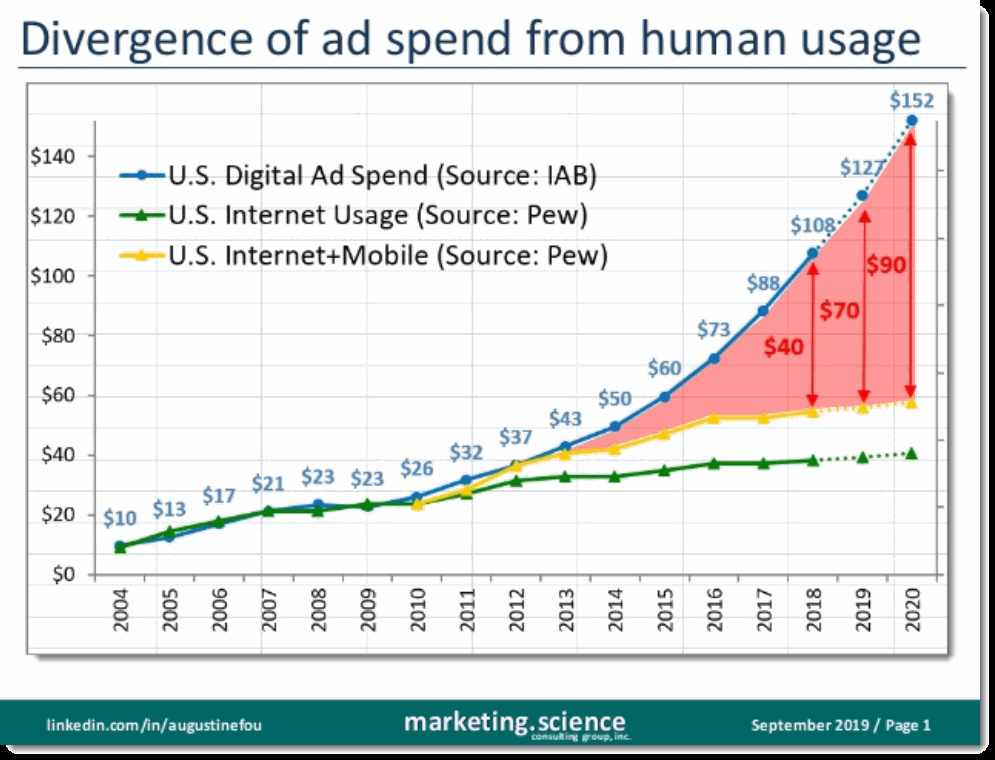Recently, I read an article written by the anti-fraud consultant, Dr. Augustine Fou that brought into focus a concern that I have with the current world of digital advertising and the increasing level of ad fraud. Not only does ad fraud cause businesses to spend their ad dollars on fake websites and clicks, but it also pollutes a company’s attribution models because it is based on bad data, which makes it even more difficult to target future ad spend.
Let’s face it, I have never been a big fan of advertising even in the days before digital marketing. Back then, this was based on not being able to measure my Return on Investment for my ad spend.
When I was an Invisible Fencing dealer in the 1980s, I recall the parent company telling me that to be successful, I had to advertise in the local newspaper every day. After months of pouring money into local newspaper ads, I was unable to attribute any of my sales directly to these ads. The ads that were converting were not the ones from my local newspaper but the national ads taken out by the parent company in specialty magazines like Dog Fancy. It felt like advertising in a local newspaper with no audience segmentation or on local TV was a black hole for my ad spend. While targeted ads in magazines like Dog Fancy were converting, ads from sources with large but undifferentiated audiences were not. My advertising experience as an Invisible Fencing dealer shaped my views of advertising for years to come even after Invisible Fencing and I parted ways.
Digital marketing was presented as the panacea to all my targeting problems and seemed like a better solution. But as digital marketing got more sophisticated, it developed loopholes and became ripe for ad fraud. While there are thousands of articles on digital marketing, and in fact, I have written a few digital marketing articles myself, the dark side of ad fraud is rarely discussed. Each year, ad fraud is getting worse because is it intentionally overlooked by the industry as it helps them sell more ads, which is the subject of this post.
At the genesis of the digital age, digital ads solved the long-standing problem of better targeting for small businesses. The promise that ads could be delivered to the ideal customer was an attractive alternative, especially to small business owners that could not afford to buy ads in national newspapers and magazines, prime time TV commercials, or radio spots like big advertisers could.
Moreover, omnichannel marketing offered the prospect of targeting consumers across multiple channels including mobile, video, and desktop. Add to that the ability to tailor the content within the context of how consumers interact with the brand such as a consumer seeing the brand for the first-time vs a consumer who had engaged with the brand previously, were attractive alternatives to direct negotiations with physical publishers.
But over time, as technology advanced, the digital ad space has been exploited by bad actors. The same technology used to better target consumers has been used to defraud ad buyers out of an ever-increasing percentage of their ad dollars. Here is what happened.

In the old days when all we had was physical media, businesses worked directly with a publisher, like a newspaper or TV/radio station, to buy ad space or a time slot the business hoped would engage the eyes and ears of their target audience. Businesses were disconnected from any direct analysis of their ads performance or ability to accurately compute a Return on Investment for their ad spend.
Then came the Internet.

The Internet gave rise to more and more digital publishers such as digital magazines, online newspapers, and blogs. Ad networks, such as predecessors of Google AdSense, emerged as a way to help advertisers buy ads from the growing number of websites, making it no longer necessary for a brand to directly work with every publisher. Ad networks existed to buy ad space from thousands of digital publishers and sell them to advertisers. Therefore, ad networks acted as a middleman in brokering ads between ad buyers and an ever-growing number of digital publishers.
While ad networks acquired the actual unused ads from publishers, they needed a way to sell this space to advertisers and ad exchanges were born. Ad networks codified their inventory of ads by targeting options, and ad exchanges used demand-side economics to establish ad pricing based on consumer behaviors, time of day, device, and even the position of the ad. Ad exchanges created real-time auctions based on competition and availability to establish the cost of ads dynamically.
Today, ad networks aggregate millions of digital publishing websites, many of which no one has ever heard of, and ad exchanges use sophisticated algorithms to automate the buying and selling of ads. Few businesses negotiate directly with digital publishers and instead, buy ads from ad exchanges where ads are displayed across thousands of sites. Because ad buyers are completely disconnected from the sites that carry their ads, loopholes created by these middlemen were exploited for ad fraud.

Many of the ad spots on websites acquired by ad networks have few if any human visitors. This creates an inventory of ads across millions of websites that are far greater than what the human population can visit. Enter the use of bots to simulate human traffic.

The misaligned incentives of ad networks and ad exchanges to generate more revenue make them willing to let fraudulent sites into the exchange because these sites generate large volumes of ad space they can sell. The programmatic algorithm makes it possible to place ads on millions of sites that no one has ever heard of, making ad fraud scalable in a way that was not possible when advertisers bought ads from real physical publishers with whom they had to negotiate.
Today, ad fraud is perpetrated in several different ways:
- Hidden ads: Ads are displayed in such a way that the user doesn’t actually see them. For example, ads are just 1×1 pixel ads, are displayed outside the viewing area, or are overlapping in an iframe. This kind of ad fraud targets ad networks that pay based on impressions vs clicks.
- Click hijacking: Hackers insert malware into computers to redirect a click from one ad to another one
- Bot ad fraud: Hackers use bots to generate thousands of fake clicks on an ad or fake visits to a website displaying the ads. Bots fake legitimate human website visitors and fake real browsers by declaring they are Chrome, Safari, or Firefox.
- Fake websites: Today, there is a significant number of fake websites that have no content except ads. Moreover, since the sites contain only random ads, no humans visit them. These fake websites were created solely to make money from advertising. Fake websites can mimic real websites by simply passing false information in bid requests.
Ad networks and ad exchanges have turned a blind eye to ad fraud as their existence helps to line their pockets. What makes matters even worse is that advertisers rely on data from attribution platforms like Google Analytics to understand the marketing interactions customers have with their brand so they can make better ad buys. However, clicks can be manufactured out of thin air by directly loading click-through URLs, affiliate links, or click trackers. Hackers can also imitate humans using mobile devices to record and replay fake engagement.
Overall, small business owners do better with digital marketing than their larger competitors who just buy numbers off a spreadsheet. Most of the major advertisers hire media agencies, adding yet another layer. Media agencies are rewarded for spending all the ad dollars assigned to them or they may lose out in subsequent years. Media agencies, in their attempts to spend all the money that major advertisers allocate to them expand their lookalike audience in a spray and pray approach.
By contrast, small business owners are more frugal with their ad spend than big advertisers and look more closely at their analytics. They are far more likely to find strange things in the analytics such as domains and apps that exhibit strange characteristics. When a small business owner discovers what appears to be ad fraud, they are more likely to add domains to “exclude lists” or remove them from their “include lists”. With a focus on campaign optimization, small business owners reduce their exposure to ad fraud and focus on buying ads from real publishers, that have real websites used by real humans. While big advertisers, who use media agencies, are more prone to quantity over quality, small business owners are more prone to focus on quality over quantity.
Dr. Augustine Fou recommends to many business clients to cut their ad spends by ten percent and see what happens to their business outcomes. If nothing happens, he recommends they cut another ten percent and so on.
To avoid exposure to ad fraud, small businesses should focus less on vanity metrics like the number of impressions and clicks that can easily be fraudulent and more on conversions where a real person completes a form or makes a purchase.
To what extent is your business exposed to ad fraud?












